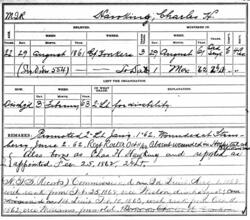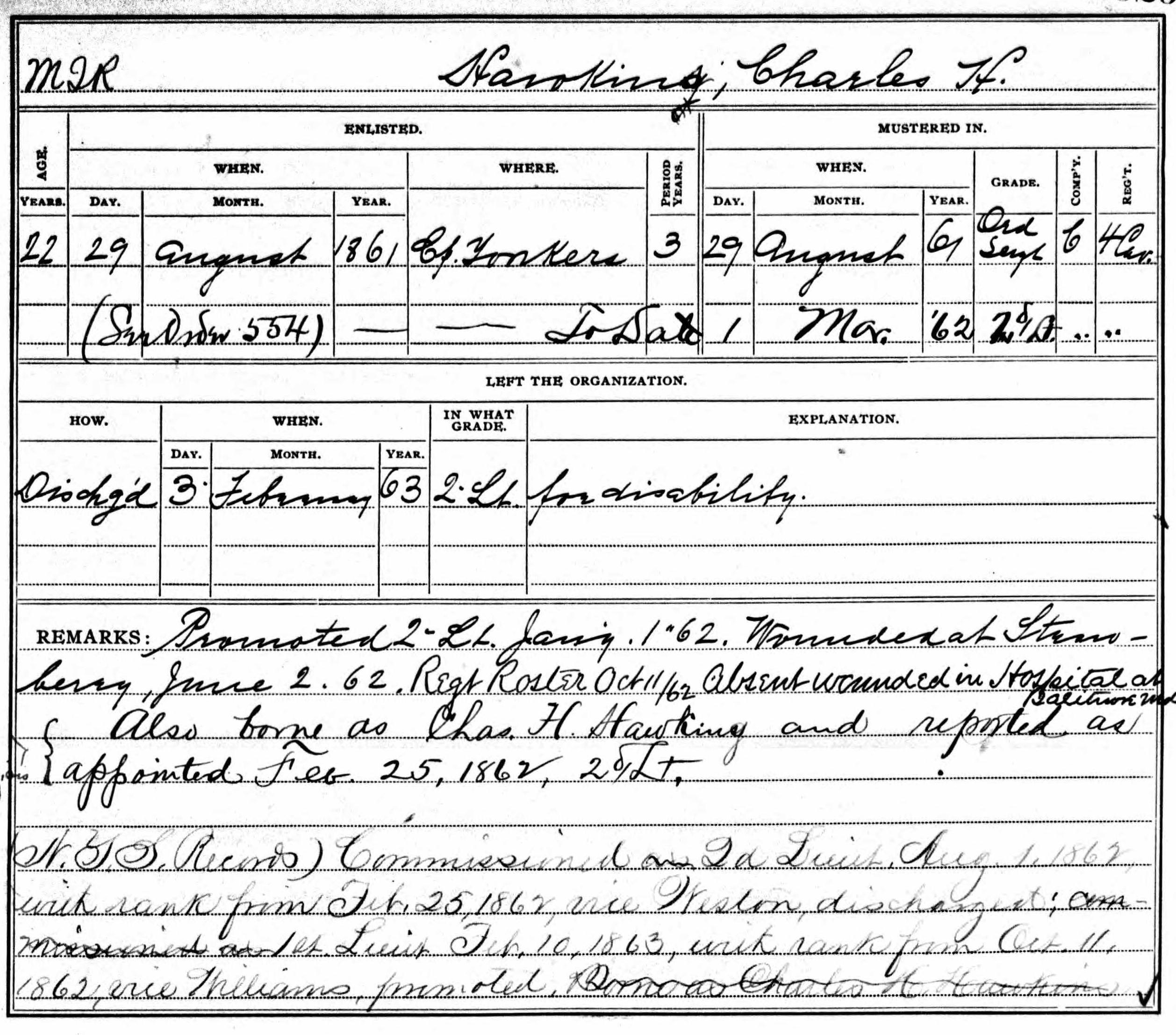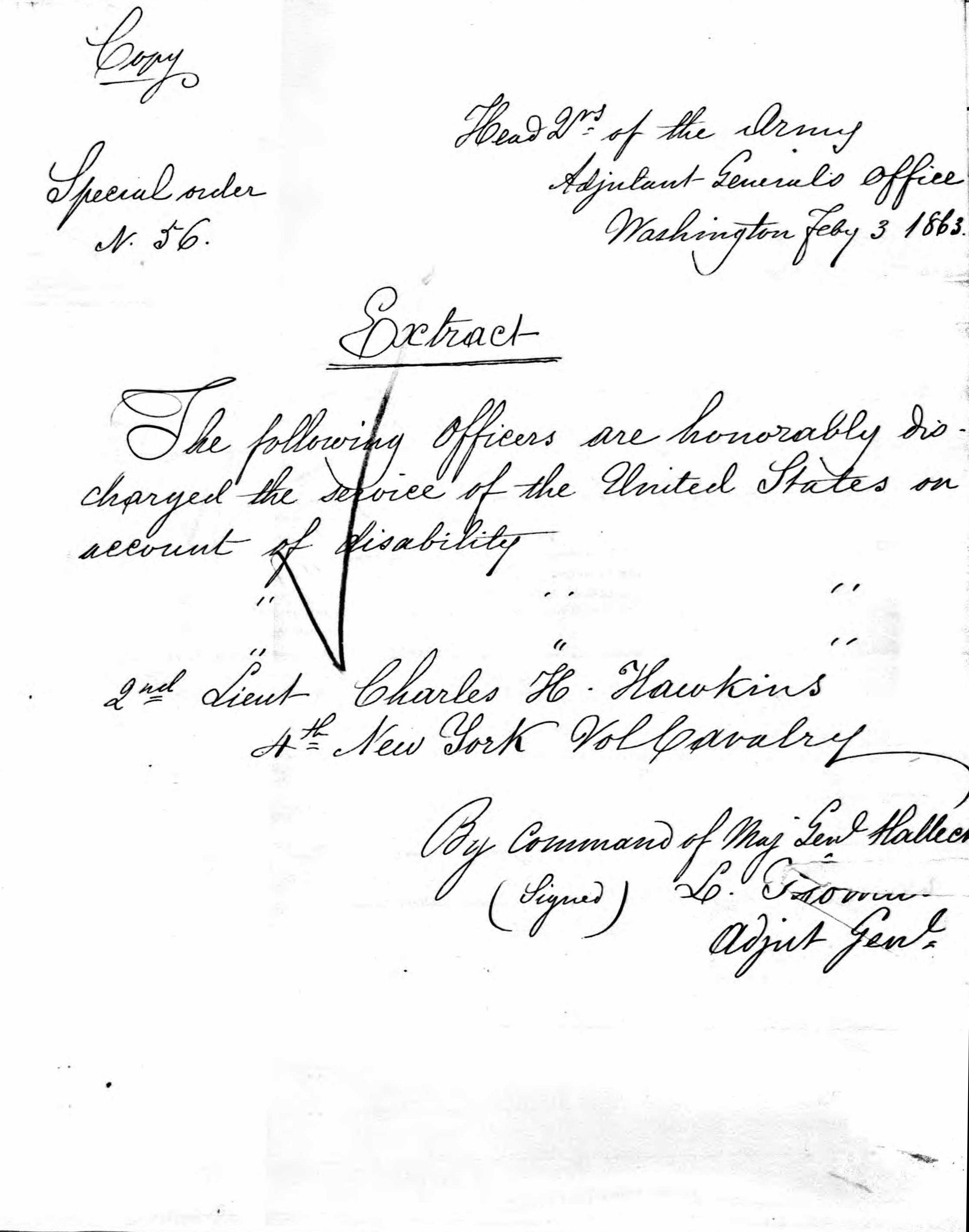"Case 337. — Charles H. Hawkins, a second lieutenant in Co. C, 4th New York Cavalry, aged 23 years, was wounded in a reconnoissance near Strasburg, Virginia, on the night of June 1, 1862. A conoidal ball, from a Colt's cavalry pistol, entered the posterior surface of the right thigh, and, passing downward and forward, fractured the femur at the lower part of the middle third, and lodged under the skin about five inches above the knee. The wounded man lay out all night in the rain, and in the sun next day until three in the afternoon, when he was brought into camp and had the ball removed by his regimental surgeon. He was then conveyed in an ambulance to a hospital in Strasburg, where his limb was dressed with a straight splint, moderate extension and counter-extension being maintained. After ten days he was carried on a stretcher to a private bouse, where he remained seventeen days. Two fragments of bone were extracted during this period. He was next transferred to a tent hospital, five miles distant, near Middletown, and after a sojourn of nine days was again transferred to a hospital at Winchester. The splints were removed and the limb was bandaged. On July 19th he was conveyed to Baltimore, and admitted to the Camden Street Hospital on July 20th. His condition was very unpromising; there was much irritative fever, a copious suppuration, and partial union of the fracture, with three inches shortening and much angular deformity. No apparatus was applied; but the limb was maintained in an easy position by pillows, and attention was mainly directed to improving the condition by wholesome diet. Two months subsequently the patient had gained ground, and an operation to remove the diseased bone and to break up the faulty union of the fragments was determined on. On October 1st, the posterior orifice was enlarged, a number of denuded fragments of bone were removed by forceps, and the deformed callus was chiseled and gouged away. Temporary improvement ensued. The limb was put in a proper position and the wound was daily syringed out by iodine injections. After a time, however, it became manifest that the broken extremities of the femur were still diseased. On April 5, 1863, the patient was transferred to the Ladies' Home Hospital, New York City, where he was received on April 8th, greatly reduced in strength. The wounds discharged profusely, and he complained of much pain. On April 29th, Surgeon A. B. Mott, U. S. V., amputated the limb at mid-thigh. Evidence that the femur was diseased above the point at which it was sawn soon became apparent, and, after a protracted effort to induce healthy action, the flaps were freely laid open and the femur was resected, four inches of the shaft being removed. After this the patient was put upon a full diet, with an allowance of brandy and of porter daily. The stump still failed to assume a healthy action, but became much enlarged, undergoing apparently a fatty degeneration. On April 4, 1864, Lieutenant Hawkins was mustered out of the military service, and was transferred to St. Luke's civil hospital, and came under the care of Dr. Guidon Buck. The patient was anaemic, his appetite capricious; he was compelled to keep his bed continually on account of the pain he suffered when the stump was in a dependent position. For over five months every means were used to bring the patient up to a condition in which an operation for the removal of the diseased femur stump might be safely undertaken. On September 21st, he was placed under the influence of sulphuric ether, and Dr. Buck proceeded to disarticulate. It was found necessary to bisect the stump, uncovering the neck of this bone on the inner as well as the outer aspect, by an incision which commenced above the great trochanter and ran around tho extremity of the bone to near the tuberosity of the ischium. During the operation the administration of ether was suspended on account of the extreme feebleness of the circulation, and brandy was freely given, and warm applications were made to the trunk. The loss of blood was not great, but every possible means had to be called into requisition to bring about a partial reaction after the operation, so great was the prostration and so feeble the recuperative powers. After twenty-four hours of great apparent suffering, the patient died in a syncope, September 22, 1864." -- The Medical and Surgical History of the War of the Rebellion. Part III, Volume II. (3rd Surgical volume) by U. S. Army Surgeon General's Office, 1883.
"Case 337. — Charles H. Hawkins, a second lieutenant in Co. C, 4th New York Cavalry, aged 23 years, was wounded in a reconnoissance near Strasburg, Virginia, on the night of June 1, 1862. A conoidal ball, from a Colt's cavalry pistol, entered the posterior surface of the right thigh, and, passing downward and forward, fractured the femur at the lower part of the middle third, and lodged under the skin about five inches above the knee. The wounded man lay out all night in the rain, and in the sun next day until three in the afternoon, when he was brought into camp and had the ball removed by his regimental surgeon. He was then conveyed in an ambulance to a hospital in Strasburg, where his limb was dressed with a straight splint, moderate extension and counter-extension being maintained. After ten days he was carried on a stretcher to a private bouse, where he remained seventeen days. Two fragments of bone were extracted during this period. He was next transferred to a tent hospital, five miles distant, near Middletown, and after a sojourn of nine days was again transferred to a hospital at Winchester. The splints were removed and the limb was bandaged. On July 19th he was conveyed to Baltimore, and admitted to the Camden Street Hospital on July 20th. His condition was very unpromising; there was much irritative fever, a copious suppuration, and partial union of the fracture, with three inches shortening and much angular deformity. No apparatus was applied; but the limb was maintained in an easy position by pillows, and attention was mainly directed to improving the condition by wholesome diet. Two months subsequently the patient had gained ground, and an operation to remove the diseased bone and to break up the faulty union of the fragments was determined on. On October 1st, the posterior orifice was enlarged, a number of denuded fragments of bone were removed by forceps, and the deformed callus was chiseled and gouged away. Temporary improvement ensued. The limb was put in a proper position and the wound was daily syringed out by iodine injections. After a time, however, it became manifest that the broken extremities of the femur were still diseased. On April 5, 1863, the patient was transferred to the Ladies' Home Hospital, New York City, where he was received on April 8th, greatly reduced in strength. The wounds discharged profusely, and he complained of much pain. On April 29th, Surgeon A. B. Mott, U. S. V., amputated the limb at mid-thigh. Evidence that the femur was diseased above the point at which it was sawn soon became apparent, and, after a protracted effort to induce healthy action, the flaps were freely laid open and the femur was resected, four inches of the shaft being removed. After this the patient was put upon a full diet, with an allowance of brandy and of porter daily. The stump still failed to assume a healthy action, but became much enlarged, undergoing apparently a fatty degeneration. On April 4, 1864, Lieutenant Hawkins was mustered out of the military service, and was transferred to St. Luke's civil hospital, and came under the care of Dr. Guidon Buck. The patient was anaemic, his appetite capricious; he was compelled to keep his bed continually on account of the pain he suffered when the stump was in a dependent position. For over five months every means were used to bring the patient up to a condition in which an operation for the removal of the diseased femur stump might be safely undertaken. On September 21st, he was placed under the influence of sulphuric ether, and Dr. Buck proceeded to disarticulate. It was found necessary to bisect the stump, uncovering the neck of this bone on the inner as well as the outer aspect, by an incision which commenced above the great trochanter and ran around tho extremity of the bone to near the tuberosity of the ischium. During the operation the administration of ether was suspended on account of the extreme feebleness of the circulation, and brandy was freely given, and warm applications were made to the trunk. The loss of blood was not great, but every possible means had to be called into requisition to bring about a partial reaction after the operation, so great was the prostration and so feeble the recuperative powers. After twenty-four hours of great apparent suffering, the patient died in a syncope, September 22, 1864." -- The Medical and Surgical History of the War of the Rebellion. Part III, Volume II. (3rd Surgical volume) by U. S. Army Surgeon General's Office, 1883.
Advertisement
Records on Ancestry
Sponsored by Ancestry
Advertisement



